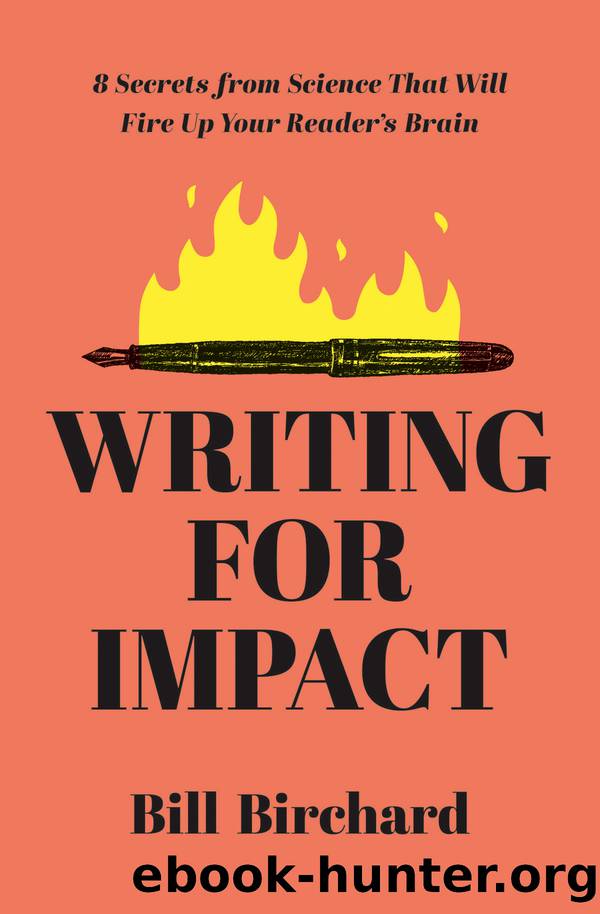Writing for Impact by Bill Birchard

Author:Bill Birchard
Language: eng
Format: epub
Publisher: Harpercollins Leadership
Published: 2023-01-30T00:00:00+00:00
CHAPTER 7
KEEP IT SOCIAL
For the Love of Readers: Connect!
How do you express yourself when only your dog is listening? That hints at the seventh secret to engaging readers. Reveal yourself. Give readers clues as to whatâs going on in your head. Let them connect with you, the author, as a thinking and feeling person.
People, and readers, have an inference engine. They infer your personality, beliefs, and motives from your display of voice, worldview, vocabulary, wit, syntax, poetic rhythm, sensibilities, and much more. They do the same for the people you write about.
Readers wake instantly to a chance to connect with you. They also want to connect with the people you include in stories and examples. They, like you, crave to know the intellectual and emotional life of those theyâre associating with. And they are rewarded when they can make that connection.
Thereâs nothing more human than that. Hardwiring prods us to take the measure of other people. How else to assure the well-being of ourselves, our family, our tribe? How else to advance ourselves among our fellows? âAt baseline, human beings are social animals, and weâre drawn to social things,â says psychologist David Dodell-Feder at the University of Rochester. âWe as a species have this fundamental interest in social things that outpaces our interest in non-social things.â1
We are particularly eager, as scientists like Dodell-Feder say, to âmentalize,â or more simply, to mind-read, to suss out whatâs in other peopleâs heads. Writers canât re-create the rich effect of interacting with people face-to-face, but they can do something almost as potent. They can drive mind-reading: Through examples, anecdotes, what-if scenarios, and stories, writers can get readers to impulsively glean whatâs in their minds and in the minds of people in their writing.
As a test, to show how much of an impact this has, hereâs Lewis Thomas again in Lives of a Cell. See if you can resist the impulse to glean whatâs going on in his mind as he fancies what kind of music would best explain humans to extraterrestrials: âI would vote for Bach, all of Bach, streamed out into space, over and over again. We would be bragging, of course, but it is surely excusable for us to put the best possible face on at the beginning of such an acquaintance.â2
Thomas surely won the National Book Award at least in part because he wrote to allow, indeed prompt, readers to think about what he and the people he was writing about were thinking. And that mind-to-mind connection is an element of social connection that you can accentuate to engage readers. When you help readers relate to you and the people on your writing stage, you help them connect as if in person. From that the rewards flow.
To be sure, if youâre a reporter for the local news, making a social connection as the author of an article may not be appropriate. As a journalist, I was instructed to keep myself and my dog out of the picture. Thatâs a rule of the trade.
Download
This site does not store any files on its server. We only index and link to content provided by other sites. Please contact the content providers to delete copyright contents if any and email us, we'll remove relevant links or contents immediately.
| Bookkeeping | Business Mathematics |
| Business Writing | Communications |
| Decision Making | Negotiating |
| Project Management | Running Meetings & Presentations |
| Secretarial Aids & Training | Time Management |
| Training |
Nudge - Improving Decisions about Health, Wealth, and Happiness by Thaler Sunstein(7622)
Deep Work by Cal Newport(6885)
Principles: Life and Work by Ray Dalio(6221)
Factfulness: Ten Reasons We're Wrong About the World – and Why Things Are Better Than You Think by Hans Rosling(4694)
The Doodle Revolution by Sunni Brown(4689)
Eat That Frog! by Brian Tracy(4436)
Thinking in Bets by Annie Duke(4154)
Hyperfocus by Chris Bailey(4053)
Visual Intelligence by Amy E. Herman(3724)
Writing Your Dissertation in Fifteen Minutes a Day by Joan Bolker(3670)
Ogilvy on Advertising by David Ogilvy(3515)
How to Win Friends and Influence People in the Digital Age by Dale Carnegie & Associates(3499)
Hidden Persuasion: 33 psychological influence techniques in advertising by Marc Andrews & Matthijs van Leeuwen & Rick van Baaren(3474)
How to win friends and influence people by Dale Carnegie(3400)
The Pixar Touch by David A. Price(3366)
Schaum's Quick Guide to Writing Great Short Stories by Margaret Lucke(3322)
Deep Work: Rules for Focused Success in a Distracted World by Cal Newport(3147)
Work Clean by Dan Charnas(3051)
The Slow Fix: Solve Problems, Work Smarter, and Live Better In a World Addicted to Speed by Carl Honore(2947)
